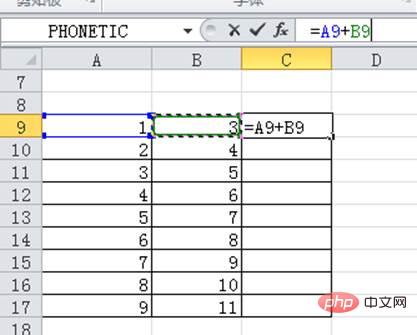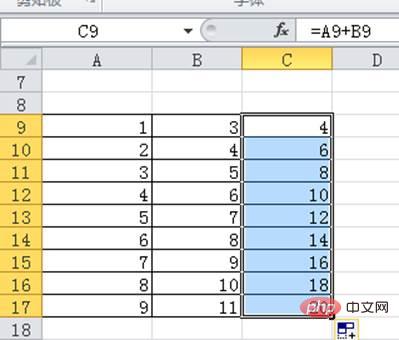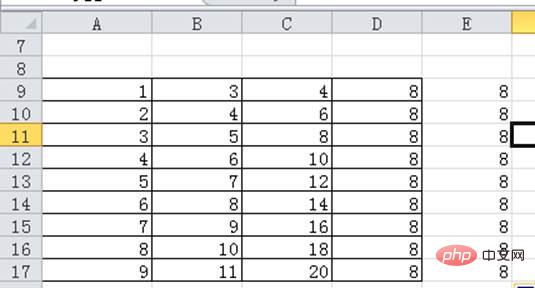 Topics
Topics
 excel
excel
 Practical Excel skills sharing: help you understand 'absolute reference' and 'mixed reference'
Practical Excel skills sharing: help you understand 'absolute reference' and 'mixed reference'
Practical Excel skills sharing: help you understand 'absolute reference' and 'mixed reference'
In the previous article " Practical Excel skills sharing: learn how to make a multi-factor ranking statistical table? 》, we learned about how to make a multi-factor ranking statistical table, and today we are going to talk about citations in Excel formulas. Don’t you understand absolute citations and mixed citations? No wonder you always fill in the wrong formulas!
Let me analyze this question for you.

After reading everyone’s comments, I found that there is a common problem with everyone’s formulas: the first parameter of each nested IF function uses the AND function to specify the data. range.
For example:

Also like this:

No matter whether the above formula is Correct, think about it, do we need to write so many ANDs?
Perhaps everyone was influenced by the tutorial - who said this tutorial just exemplified the AND function, and who said the subsidy years could just be described by AND? Haha...
(In the last question, due to the carelessness of the bottle, I forgot to write down the subsidy for more than 10 years! I will punish myself by writing more tutorials, so now we will unify that the subsidy for more than 10 years is also 600) There are two ways to write the
formula. The first one is:
=IF(C:C
When the number in column C is less than 1, return 0, otherwise Just look at the second IF directly. At this time, the default is greater than or equal to 1, so the second IF only needs to write the upper limit of the number, which is less than 2. The following is the same.
The above formula limits all upper limits. In fact, it can also limit all lower limits. The second type:
=IF(C:C>=8,600,IF(C:C> ;=6,400,IF(C:C>=4,300,IF(C:C>=2,200,IF(C:C>=1,100,0)))))
When column C When the number is greater than or equal to 8, it returns 600, when it is greater than or equal to 6, it returns 400, when it is greater than or equal to 4, it returns 300, when it is greater than or equal to 2, it returns 200, when it is greater than or equal to 1, it returns 100, otherwise it returns 0.
You can find that if you use IF to answer this question, use the second method and set the lower limit of the data every time, which is easier to understand.
In addition, Bo Bo also wants to tell you that when entering formulas in the edit bar, sometimes you don’t have to enter them manually. For example, in the above formula, we directly click on column number C, and it will appear in the formula. C:C. The formula written by the second friend above uses absolute reference. You can also directly drag and select the data area B5-B14 and press F4, and it will become $B$5:$B$14.
Maybe those who are just getting started don’t know much about relative references and absolute references. Today Bottle will explain them to you.
1. Relative reference
As shown below, the data in columns A and B are summed, and the summation result is displayed in column C. .

As shown below, after selecting cell C9, enter the equal sign in the edit bar, then directly click on cell A9, enter the plus sign, and then directly click on cell B9. Finally enter.

Select cell C9, place the mouse in the lower right corner, double-click, and you can see that the entire column has been summed.

At this time, we click on the cells in column C one by one, and we can see the formula in the edit bar. As we move down, the row number will also change. Change to the corresponding line number.


You can try entering the formula in cell A18, summing column A, and drag the fill formula horizontally to cell C18. . You will see that when you drag the formula horizontally, the column number will automatically change to the corresponding column number. This is called a relative reference. The relative reference format of a cell is the column number and row number. For example, A10, B14, etc. are all relative references. The biggest feature of relative references is that when you drag to fill in a formula, the cell will automatically change based on the location of the formula.
2. Absolute reference
What is an absolute reference?
As shown in the figure below, select cell D9, enter =sum(), click in the square brackets, directly drag to select A9-C9, then press F4, and finally press Enter.

At this time, double-click to fill in the formula, and then click on each cell in column D to view the formula. You will find that the formulas in the entire column are exactly the same. What is the difference between

and relative reference? The difference is that the row number and column number referenced in the current formula are preceded by the "$" symbol. $ is a "lock" that locks the cell, so no matter we pull it horizontally or vertically, the formula will not change in any way. This is called an absolute reference.
3. Mixed Reference
In the previous formula, the row number and column number are both "locked", but think about it, When filling in the formula vertically, the column number will not change even if we do not lock the column number.
As shown below, in cell E9, after entering =sum(), click in the square brackets, drag and select the cell range A9-C9, and then press F4 twice. At this time, only the rows are locked. Number.

After double-clicking to fill down, you can see that the result is exactly the same as the previous absolute reference result.

This kind of operation that only locks the row number or column number is called a mixed reference. Mixed means that cell references include both absolute references and relative references. For example, $A1 means that the column number of the cell is an absolute reference and the row number is a relative reference. The trick to mixed references is: pull down to lock only the row number, and pull to the right to lock only the column number. This way the formula will not change during the dragging process.
It’s time to verify everyone’s learning results!
Look at the table below. The corresponding columns and rows need to be displayed in cells B2-E5. The bottle has set the formula in cell B2. Now think about it, in the formula How to "lock" the row number and column number so that the entire area can be filled in at once?

Leave your answer in the comment area below!
Related learning recommendations: excel tutorial
The above is the detailed content of Practical Excel skills sharing: help you understand 'absolute reference' and 'mixed reference'. For more information, please follow other related articles on the PHP Chinese website!

Hot AI Tools

Undress AI Tool
Undress images for free

Undresser.AI Undress
AI-powered app for creating realistic nude photos

AI Clothes Remover
Online AI tool for removing clothes from photos.

Clothoff.io
AI clothes remover

Video Face Swap
Swap faces in any video effortlessly with our completely free AI face swap tool!

Hot Article

Hot Tools

Notepad++7.3.1
Easy-to-use and free code editor

SublimeText3 Chinese version
Chinese version, very easy to use

Zend Studio 13.0.1
Powerful PHP integrated development environment

Dreamweaver CS6
Visual web development tools

SublimeText3 Mac version
God-level code editing software (SublimeText3)

Hot Topics
 What should I do if the frame line disappears when printing in Excel?
Mar 21, 2024 am 09:50 AM
What should I do if the frame line disappears when printing in Excel?
Mar 21, 2024 am 09:50 AM
If when opening a file that needs to be printed, we will find that the table frame line has disappeared for some reason in the print preview. When encountering such a situation, we must deal with it in time. If this also appears in your print file If you have questions like this, then join the editor to learn the following course: What should I do if the frame line disappears when printing a table in Excel? 1. Open a file that needs to be printed, as shown in the figure below. 2. Select all required content areas, as shown in the figure below. 3. Right-click the mouse and select the "Format Cells" option, as shown in the figure below. 4. Click the “Border” option at the top of the window, as shown in the figure below. 5. Select the thin solid line pattern in the line style on the left, as shown in the figure below. 6. Select "Outer Border"
 How to filter more than 3 keywords at the same time in excel
Mar 21, 2024 pm 03:16 PM
How to filter more than 3 keywords at the same time in excel
Mar 21, 2024 pm 03:16 PM
Excel is often used to process data in daily office work, and it is often necessary to use the "filter" function. When we choose to perform "filtering" in Excel, we can only filter up to two conditions for the same column. So, do you know how to filter more than 3 keywords at the same time in Excel? Next, let me demonstrate it to you. The first method is to gradually add the conditions to the filter. If you want to filter out three qualifying details at the same time, you first need to filter out one of them step by step. At the beginning, you can first filter out employees with the surname "Wang" based on the conditions. Then click [OK], and then check [Add current selection to filter] in the filter results. The steps are as follows. Similarly, perform filtering separately again
 How to change excel table compatibility mode to normal mode
Mar 20, 2024 pm 08:01 PM
How to change excel table compatibility mode to normal mode
Mar 20, 2024 pm 08:01 PM
In our daily work and study, we copy Excel files from others, open them to add content or re-edit them, and then save them. Sometimes a compatibility check dialog box will appear, which is very troublesome. I don’t know Excel software. , can it be changed to normal mode? So below, the editor will bring you detailed steps to solve this problem, let us learn together. Finally, be sure to remember to save it. 1. Open a worksheet and display an additional compatibility mode in the name of the worksheet, as shown in the figure. 2. In this worksheet, after modifying the content and saving it, the dialog box of the compatibility checker always pops up. It is very troublesome to see this page, as shown in the figure. 3. Click the Office button, click Save As, and then
 Where to set excel reading mode
Mar 21, 2024 am 08:40 AM
Where to set excel reading mode
Mar 21, 2024 am 08:40 AM
In the study of software, we are accustomed to using excel, not only because it is convenient, but also because it can meet a variety of formats needed in actual work, and excel is very flexible to use, and there is a mode that is convenient for reading. Today I brought For everyone: where to set the excel reading mode. 1. Turn on the computer, then open the Excel application and find the target data. 2. There are two ways to set the reading mode in Excel. The first one: In Excel, there are a large number of convenient processing methods distributed in the Excel layout. In the lower right corner of Excel, there is a shortcut to set the reading mode. Find the pattern of the cross mark and click it to enter the reading mode. There is a small three-dimensional mark on the right side of the cross mark.
 How to set superscript in excel
Mar 20, 2024 pm 04:30 PM
How to set superscript in excel
Mar 20, 2024 pm 04:30 PM
When processing data, sometimes we encounter data that contains various symbols such as multiples, temperatures, etc. Do you know how to set superscripts in Excel? When we use Excel to process data, if we do not set superscripts, it will make it more troublesome to enter a lot of our data. Today, the editor will bring you the specific setting method of excel superscript. 1. First, let us open the Microsoft Office Excel document on the desktop and select the text that needs to be modified into superscript, as shown in the figure. 2. Then, right-click and select the "Format Cells" option in the menu that appears after clicking, as shown in the figure. 3. Next, in the “Format Cells” dialog box that pops up automatically
 How to use the iif function in excel
Mar 20, 2024 pm 06:10 PM
How to use the iif function in excel
Mar 20, 2024 pm 06:10 PM
Most users use Excel to process table data. In fact, Excel also has a VBA program. Apart from experts, not many users have used this function. The iif function is often used when writing in VBA. It is actually the same as if The functions of the functions are similar. Let me introduce to you the usage of the iif function. There are iif functions in SQL statements and VBA code in Excel. The iif function is similar to the IF function in the excel worksheet. It performs true and false value judgment and returns different results based on the logically calculated true and false values. IF function usage is (condition, yes, no). IF statement and IIF function in VBA. The former IF statement is a control statement that can execute different statements according to conditions. The latter
 How to insert excel icons into PPT slides
Mar 26, 2024 pm 05:40 PM
How to insert excel icons into PPT slides
Mar 26, 2024 pm 05:40 PM
1. Open the PPT and turn the page to the page where you need to insert the excel icon. Click the Insert tab. 2. Click [Object]. 3. The following dialog box will pop up. 4. Click [Create from file] and click [Browse]. 5. Select the excel table to be inserted. 6. Click OK and the following page will pop up. 7. Check [Show as icon]. 8. Click OK.
 How to read excel data in html
Mar 27, 2024 pm 05:11 PM
How to read excel data in html
Mar 27, 2024 pm 05:11 PM
How to read excel data in html: 1. Use JavaScript library to read Excel data; 2. Use server-side programming language to read Excel data.






